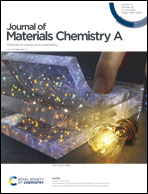Dual-metal Ni and Fe phthalocyanine/boron-doped g-C3N4Z-scheme 2D-heterojunctions for visible-light selective aerobic alcohol oxidation†
Abstract
The rational development of g-C3N4-based photocatalysts remains a great challenge for selective aerobic alcohol oxidation. Herein, sub-nanoscale nickel phthalocyanine (NiPc)–iron phthalocyanine (FePc) J-type aggregates were assembled on boron-doped g-C3N4 (BCN) driven by H-bonding interactions to obtain novel dimension-matched NiPc–FePc/BCN heterojunctions. The optimal NiPc–FePc/BCN photocatalyst, found by altering the Ni : Fe ratio, achieves an 8-fold visible-light conversion rate as compared to that of CN for benzyl alcohol (BA) oxidation and nearly 100% selectivity to benzyl aldehyde (BAD). The enhanced photoactivity is attributed to the wide-spectrum light absorption and more importantly, the facilitated charge separation due to cascade Z-scheme electron transfer from BCN to FePc and then to NiPc, evidenced by experimental and theoretical results. Notably, the synergy of NiPc and FePc was found to promote the catalytic O2 reduction to produce reactive ˙O2− radicals, which dominate the selective oxidation with the mild holes of BCN. This work showcases a novel strategy for developing advanced Z-scheme photocatalytic systems for green organic synthesis.



 Please wait while we load your content...
Please wait while we load your content...